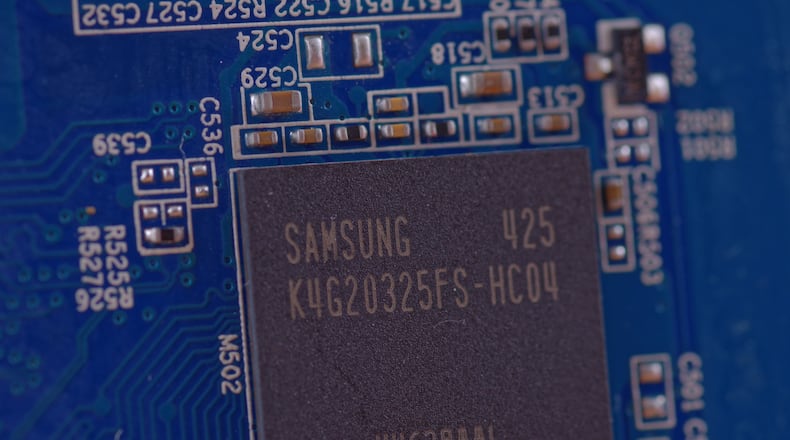Your new phone arrives. But it’s missing a single chip. No big deal, right? Buy a replacement part at a local electronics store. Except the chip you need isn’t at the nearby store – in fact, the chip likely isn’t in a store at all.
We face a global semiconductor shortage. But within this challenge lies an opportunity, one that doesn’t require Georgia to make chips, one where the Peach State can draw upon its natural strengths.
Chip shortage explained
Semiconductors power the modern economy. They enable everything from microwaves to heart monitors to nuclear facilities. Their ubiquity makes one wonder why you can’t restock them from one warehouse to another, as you can refuel from one gas station to another.
That’s because producing a chip is less like mining for oil and more like building a plane. Composed of transistors, diodes, and resistors, among other parts – these integrated circuits are simple in concept but can be byzantine in design. From start to finish, manufacturing a chip involves massive facilities, dustless rooms, and multimillion-dollar machines that can convert raw silicon into a system of billions of tiny switches. Production normally requires over three months – and under current market conditions, up to a year. By comparison, it takes less than three months to build a Boeing 777. And the price tag to start a factory (knowns as “fabs” for fabrication)? About $4 billion for mid-level chips. And plenty of start-ups have failed.
Credit: contributed
Credit: contributed
The global shortage was felt here, as the COVID-19 pandemic pushed more Georgians to work, study, and entertain from home. Schools scrambled to find laptops for online classes. Hospitals coped with rising numbers of patients and limited respirators. In West Point, the Kia car assembly plant shut down 3 times, citing semiconductor and supply chain issues.
Georgia’s position in semiconductor ecosystem
In response, Senators Jon Ossoff and Raphael Warnock supported passage of the CHIPS Act. Likely to become law by 2022, the bill is designed to bolster domestic semiconductor research, design and manufacturing to the tune of $52 billion.
Credit: contributed
Credit: contributed
But the Peach State can do more. Georgia has natural advantages in logistics, education, and position as a technology hub. Ranked No. 1 for Supply Chain and Logistics Hubs, Georgia boasts the 4th-largest seaport in the nation and the world’s busiest airport. Combined with its robust and diverse university system, the state has become home to billion-dollar tech startups and conglomerates. For these reasons and more, Atlanta was designated the No. 1 Tech Hub spot.
But Georgia currently hosts no fabs. Given the towering, perhaps cost-prohibitive, barriers to entry to building one from scratch, Georgia will likely be passed over for direct private and federal funding opportunities. Chip factories may subcontract out work to Georgian firms. But don’t expect to see ribbon-cutting ceremonies for Georgian fabs any time soon. Moreover, we will need to contend with the continuing spread of COVID-19 and its variants, the possibility of natural disasters striking fabs and dynamic geopolitical and domestic policies that may disrupt the semiconductor supply chain.
What can Georgia do?
Georgia could take steps previously thought impractical without a national imperative. For example, in line with the Biden administration’s call for more transparency, Georgia could encourage procurers and suppliers across the country to provide deeper visibility into the semiconductor supply chain. Georgia could not carry this out alone. But the Georgia congressional delegation could leverage our considerable position as a logistics hub to work with leaders in other states with fabs to require more transparency.
Georgia could assist businesses to purchase chips online. Dealing online gives buyers a more complete look at changing supply at-large and in real-time. The Georgia Department of Economic Development and the Georgia Technology Authority could help businesses upgrade their digital infrastructure and operations to conduct such negotiations.
Georgia could support companies to diversify their supplier base. This is easier said than done, because chips are not interchangeable and new production takes a while. To encourage this change, Georgia could provide tax and other incentives.
Georgia could strengthen its STEM education programs to streamline students for jobs in the semiconductor industry. The Peach State could also provide training grants targeted to veterans, underrepresented populations and other groups with employment barriers. The return on investment is admittedly in the mid- to long-term.
Finally, Georgia could continue to attract foreign investment for parts along the chips supply chain. SK Group and partners recently announced that it would build a factory in Covington to make glass parts for semiconductors. That’s $473 million in investment and over 400 new jobs. The glass technology, in fact, was developed by a Georgia Tech team, including then-researcher Sung Jin Kim, who now works for SK Group. An advanced glass factory is no fab, but this unprecedented investment signals room for growth.
Georgia does not have the expansive tools of the federal government to reshape the global semiconductor industry. But it has instruments of state power – of coordination, of investment, of public education – that can help wrest this crisis in favor of our state and our country. The Peach State shouldn’t let this crisis go to waste.
Daniel Aum is a Ph.D. student and a research assistant in the Sam Nunn School of International Affairs at Georgia Tech. Christopher Lindbeck is a computer science major at Georgia Tech and a robotics researcher at Georgia Tech Research Institute.
About the Author
Keep Reading
The Latest
Featured



